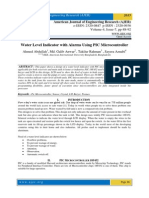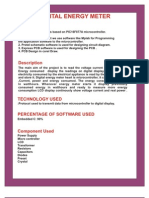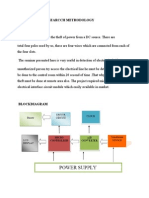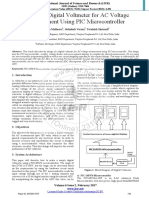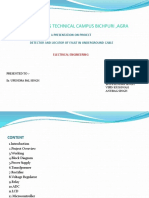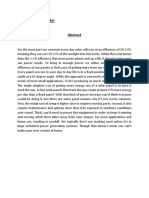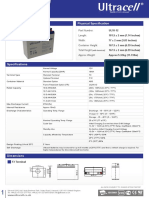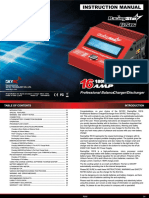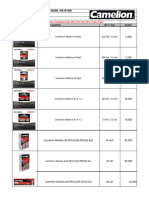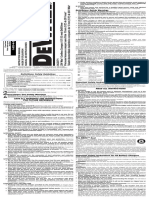Professional Documents
Culture Documents
Automatic Battery Charger
Copyright
Available Formats
Share this document
Did you find this document useful?
Is this content inappropriate?
Report this DocumentCopyright:
Available Formats
Automatic Battery Charger
Copyright:
Available Formats
Volume 7, Issue 6, June – 2022 International Journal of Innovative Science and Research Technology
ISSN No:-2456-2165
Automatic Battery Charger
Shubhangi Joshi(Author) A.G. Kole A. Nalawade
ECE, MITSOE ECE, MITSOE ECE, MITSOE
Pune, India Pune, India Pune, India
Abstract:- We've created an automated battery operating Crisantus Oden proposes a simple 12volts charger that
system based on battery status. When the battery is fully operates by providing a fixed DC or DC power source for a
charged the status is displayed on the LCD and charging rechargeable battery. A simple charger does not convert output
stops, and charging begins when the battery is not fully based on time or battery charging. This simplicity means that a
charged. This is beneficial as it prevents the battery from simple charger is less expensive. The battery charger circuit has
damaging and charging excessively. We have created an the ability to convert voltages from one form to another
automatic charging system based on its battery status. (usually AC to DCvoltages). This process is done using the
When the battery is fully charged the status is displayed on most important components such as: rectifiers, capacitor to
the LCD and charging stops, and charging begins when the filter and remove ripples from AC source and power control
battery is not fully charged. This is beneficial as it prevents (IC). However, the project is based on the development of a
the battery from getting damaged and overcharged. simple 24V / 12volts battery charger with local features to
reduce costs. The proposed project design works on 24V / 12V
Keywords:- Pic16f877a, Electric Sensor, Temperature batteries. There is a resistor connected to the battery charger to
Sensors, Current Sensor, Esp8266. limit short circuit current. [2]
I. INTRODUCTION J.Ripley, M.T.Ansari and J.Dehn use batteries and battery
chargers in both DC and AC power systems. This paper
The aim of the project is to design an automatic battery contains information on important information related to:
charger. The features of the devices are as follows. The device battery types; standard DC load recommendations; standard
is suitable for closed 12-lead lead-acid batteries, as these charging features; site and loading conditions affect battery
batteries are selected for use frequencies. The device contains storage and battery life; charger features that improve battery
a pic16f877a microcontroller that constantly monitors Voltage, storage and battery life; requirements when using compatible
Current and Battery temperature. Permanent cuts and chargers and / or batteries; manual battery monitoring methods;
automatic cuts are the methods used to charge the battery. and automatic battery monitoring. [3]
Charging starts when the voltage is below 12v and turns off
when the voltage is above 12v. III. DETAILS OF PROPOSED SYSTEM MODULES
II. BOOK RESEARCH A. Pic16f877a
Mr. V. Krishnamurthy, Rashmi Varma, Sonali Tribhuvan
and Afrin Shaikh designed the battery charger for closed 12V
lead-acid batteries. The device is designed to include the
Charging Unit, the Battery Housing Unit (Drawers) and their
separate batteries within the Chargers that can be charged
simultaneously. Each Battery Housing unit is provided with its
driver circuit, transformer and power supply module. The
power supply module is designed for thermal analysis &
efficiency and protection in EMI / EMC matters. Once the
battery is connected to the circuit, it indicates the charging
status of the battery. The battery charging level is indicated by
LEDS and the LCD is used to display the battery-powered and
current battery power with the 4X4 manual. The type of battery
and the remaining charging time are displayed on the screen
during charging of the LCD display. PIC 18f452
Microcontroller constantly monitors battery status and displays
on LCD. Charging stops when the battery is fully charged, the
sound alarm is displayed with a buzzer and finally the drawer
of the drawer tray to remove the charged battery. At the front
of the charger are 6 buttons, an LCD, a keypad and 6 LEDs.
Fast charging and slow charging facilities are provided as Fig 1:- Pic16f877a
required. The main charger circuit is the current constant
charging mode. [1] This powerful (200 nanosecond instruction) but easy to
execute (only 35 word instructions) CMOS FLASH-based 8-
bit microcontroller packs a powerful Microchip PIC® design
IJISRT22JUN1762 www.ijisrt.com 1039
Volume 7, Issue 6, June – 2022 International Journal of Innovative Science and Research Technology
ISSN No:-2456-2165
in a 40- or 44-pin pack and goes up compatible with
PIC16C5X, PIC12CXXX and PIC16C7X devices.
PIC16F877A includes 256 bytes EEPROM data memory,
editing, ICD, 2 templates, 8 10-bit Analog-to-Digital (A / D)
converter channels, 2 scanning / comparisons / PWM
functions, a compatible serial port can be configured as a 3
Serial Peripheral Interface (SPI ™) or an Inter-Integrated
Fig 3 Current Sensor
Circuit (I²C ™) bus with 2 cables and a Universal
Asynchronous Receiver Transmitter ( USART). All of these
D. Esp8266
features make it ideal for advanced A / D applications in
The ESP8266 WiFi Module is a self-contained SOC with
automotive, industrial, electronics and consumer applications.
an integrated TCP / IP protocol stack that can give any
microcontroller access to your WiFi network. ESP8266 is able
B. Buck Converter
to host the program or release all Wi-Fi network activities on
The buck converter (drop converter) is a DC-to-DC
another application processor.
power converter that lowers the voltage (while pulling the
minimum current) from its input (supplied) to the output
(load). The modified power supply phase (SMPS) typically
consists of at least two semiconductors (diode and transistor,
although modern color converters often replace the diode with
a second transistor used for parallel adjustment) and a single
energy storage element. , capacitor, inductor, or these two are
combined. To reduce the voltage ripple, capacitors made of
capacitors (sometimes combined with inductors) are usually
added to the output of the converter (filter next to the load) and
inputs (supply side filter). [1] It is called a buck converter
because the voltage across the inductor "dollars" or
counteracts the supply voltage.
Switch converters (such as color converters) offer greater Fig 4 Esp8266
power efficiency as DC-to-DC converters than line controls,
which are simple circuits that reduce voltage by output power E. LCD Module
such as heat, but do not increase output power. An LCD is an electronic display module that uses liquid
crystal to produce a visual image. The 16 × 2 LCD display is
The efficiency of the color converters can be very high, the most basic module used in this project to communicate
often over 90%, making them useful for tasks such as directly with people. 16 × 2 translates o the display of 16 letters
converting large computer power, usually 12 V, down to the in each line on 2 such lines.
low voltage required by USB, DRAM and -CPU, which is.
usually 5, 3.3 or 1.8 V.
Fig 5 LCD Display
Fig 2 Buck Converter
IV. PROPOSED SYSTEM DESCRIPTION
C. Current Sensor
The ACS712 is a fully integrated current line sensor, The sensors embedded within the system send
based on the hall output with a 2.1kVRMS voltage divider and information to the control unit and are monitored during
an integrated ground-resistant current conductor. The continuous operation. If the voltage is less than 12v then the
technical terms, on the other hand, are simply set as the current current is checked, if it is mA then charging is started by
sensor that the operator uses to calculate and measure the turning on the relay switch and buck and the charging process
current value used. stops as soon as the current is not visible.
IJISRT22JUN1762 www.ijisrt.com 1040
Volume 7, Issue 6, June – 2022 International Journal of Innovative Science and Research Technology
ISSN No:-2456-2165
The charging process starts when the voltage is below
12v and stops when the voltage is above 12v with the help of
a relay. Finally we receive a notification on the phone via
esp8266.
VI. PCB BOARD OUTPUT
Fig 8:- PCB Board Output
Fig 6 The performance of the proposed system is shown in the
figure above where the software provided by the
V. WORKING OF THE SYSTEM microcontroller contains a voltage and current value, based on
which the charging process is determined.
VII. CONCLUSION
The use of Automatic Battery Charge Channel is a new
way to overcome the risk of an explosion. It also solved the
problem of battery decay. It works well and reduces staff
capacity, retention and complexity. There is no need to
constantly monitor batteries and charging changes.
THE FUTURE PLAN
For future recommendations, our charging input should
be on high to reduce battery charging time. Besides, the
charger should come with a small size so that users can use it
freely anywhere.
REFERENCES
Fig 7 [1]. Mr. V. Krishnamurthy “Automatic Battery Charger”
2014 International Journal of Engineering and
The block diagram contains LCD, MCU (pic16f877a), Technology Research.
esp8266, Voltage sensor, current sensor, Relay, Buck [2]. Crisantus Oden, LI Huizong School of Management and
Converter, closed acid battery. Economic Anhui University of Science and Technology
Huainan, China “Design and Construction of 12 Volts
Once the battery is connected to the circuit, it then Automatic Battery Charger” 2011, IEEE Journal
displays the battery charging status on the LCD. [3]. J. Ripley, M. T. Ansari, J. Dehn, “Battery Chargers and
DC batteries and power systems that support AC”,
Current sensor and voltage sensor are used to sense Record of conference papers. IEEE has embraced the
current and current voltage in the battery. The MCU constantly industry application community. Forty-eighth Annual
monitors the battery status and is displayed on the LCD. Conference. 2001 Oil and Industrial Industry Conference
Technology Conference, 26 September 2001.
IJISRT22JUN1762 www.ijisrt.com 1041
Volume 7, Issue 6, June – 2022 International Journal of Innovative Science and Research Technology
ISSN No:-2456-2165
[4]. Asep nugroho, Estiko Rijanto, Latif Rozaqi “Control
Buck converter lead battery charger using current high-
speed mode” International Journal of Power Electronics
and Driving Systems (JPEDS), Vol. 8, No. June 2, 2017
[5]. S. Anuphappharadorn, S. Sukchai, C. Sirisamphanwong,
and N. Ketjoy, "Compare the Economic Analysis of
Battery between Lithium-ion and Lead-acid in the PV
Stand-alone Application," Energy Procedia, vol. 56, no.
C, pages 352–358, 2014.
[6]. Matsushita Battery Industrial Co.Ltd., “Panasonic Sealed
Lead-Acid Technical Handbook 2000,” pp.1-77, January
2000.
[7]. E. Koutroulis and K. Kalaitzakis, “New battery charging
system for photovoltaic applications,” IEEE Proc. -
Electr. Power Appl., Vol. 151, no. 2, p. 191, 2004.
IJISRT22JUN1762 www.ijisrt.com 1042
You might also like
- FinalDocument33 pagesFinalnaveenaNo ratings yet
- Mpi Final Report V FinalDocument16 pagesMpi Final Report V FinalAsim AslamNo ratings yet
- Industrial Conveyor Belt Object CounterDocument15 pagesIndustrial Conveyor Belt Object CounterRavi Joshi100% (1)
- Micro Controller Based Solar ChargerDocument24 pagesMicro Controller Based Solar Chargerbalu54100% (2)
- Automatic Water Level Indicator using MicrocontrollerDocument3 pagesAutomatic Water Level Indicator using Microcontrollerjahidul hasanNo ratings yet
- Block Diagram: Solar PanelDocument14 pagesBlock Diagram: Solar PanelAakash SheelvantNo ratings yet
- Design Simulation and Hardware Construction of An Arduino Microcontroller Based DC DC High Side Buck Converter For Standalone PV SystemDocument6 pagesDesign Simulation and Hardware Construction of An Arduino Microcontroller Based DC DC High Side Buck Converter For Standalone PV SystemEditor IJTSRDNo ratings yet
- Project T1Document10 pagesProject T1AVIDIP DEYNo ratings yet
- ACEET Water Leakage Detection SystemDocument25 pagesACEET Water Leakage Detection SystemSujesh ChittarikkalNo ratings yet
- Measure Battery Charge at a GlanceDocument27 pagesMeasure Battery Charge at a GlanceAyuguNo ratings yet
- Battery Charger Using Bicycle: 1 Problem StatementDocument14 pagesBattery Charger Using Bicycle: 1 Problem Statementbenny bullNo ratings yet
- Solar Energy Generator System DesignDocument14 pagesSolar Energy Generator System DesignMerlin SithNo ratings yet
- Homeappliances JAETDocument4 pagesHomeappliances JAETMICHEL MUÑOZNo ratings yet
- Team 4 Technical Report[1]Document12 pagesTeam 4 Technical Report[1]abdelrahmanmoataz0No ratings yet
- Design and Implementation of Solar Based DC Grid Using Arduino UnoDocument5 pagesDesign and Implementation of Solar Based DC Grid Using Arduino UnoMobeenNo ratings yet
- AN3392 - Building The NiCd - NiMH BatteryDocument12 pagesAN3392 - Building The NiCd - NiMH BatteryUnu DecebalNo ratings yet
- Energy Monitoring SystemDocument26 pagesEnergy Monitoring SystemFebzNo ratings yet
- Technical Research Paper Microcontroller Based Fault DetectorDocument8 pagesTechnical Research Paper Microcontroller Based Fault DetectorM S Daniel WesliyNo ratings yet
- JETIR1903B17Document5 pagesJETIR1903B17Tanmay RathodNo ratings yet
- Water Level Indicator With Alarms Using PIC MicrocontrollerDocument5 pagesWater Level Indicator With Alarms Using PIC MicrocontrollerAJER JOURNALNo ratings yet
- Highway Speed CheckerDocument24 pagesHighway Speed Checkerritesh chauhanNo ratings yet
- Propeller Led Display For ImagesDocument7 pagesPropeller Led Display For ImagesMuhamad SaipudinNo ratings yet
- Stationary Bike Charger with Odometer, Speedometer & Calories CounterDocument12 pagesStationary Bike Charger with Odometer, Speedometer & Calories CounterLaurenze SariNo ratings yet
- LED Lighting SolutionsDocument20 pagesLED Lighting SolutionsFábio Carvalho FurtadoNo ratings yet
- Digital Energy MeterDocument3 pagesDigital Energy MeterbapoonprdNo ratings yet
- Temperature Based Fan Controller: Richa NiveditaDocument28 pagesTemperature Based Fan Controller: Richa NiveditakumareshNo ratings yet
- 07-Design and Implementation of Smart Energy MeterDocument59 pages07-Design and Implementation of Smart Energy MeterAvetri VigneshwaranNo ratings yet
- 2.1.5 LCD Display: 2.1.7 GSM DeviceDocument9 pages2.1.5 LCD Display: 2.1.7 GSM DeviceHamza AliNo ratings yet
- TachometerDocument51 pagesTachometerKiran SugandhiNo ratings yet
- Arduino AC-DC Voltmeter PDFDocument6 pagesArduino AC-DC Voltmeter PDFyb3hgf2222No ratings yet
- Driving LEDs With A PIC MCDocument11 pagesDriving LEDs With A PIC MCLavinia MăgeruşanNo ratings yet
- Mcu-Based Battery Management System For Fast Charging of Iot-Based Large-Scale Battery-CellsDocument5 pagesMcu-Based Battery Management System For Fast Charging of Iot-Based Large-Scale Battery-CellsPeriyasamyNo ratings yet
- Water Automation Project ReportDocument23 pagesWater Automation Project ReportMahdee NafisNo ratings yet
- Experiment - 9 Study of Battery Using MicrocontrollerDocument4 pagesExperiment - 9 Study of Battery Using MicrocontrollergodfreyNo ratings yet
- Irrigation Project ReportDocument69 pagesIrrigation Project Reportbvkarthik2711No ratings yet
- A User Programmable Battery Charging SystemDocument5 pagesA User Programmable Battery Charging SystemIonicNo ratings yet
- TheftDocument12 pagesTheftEmeka Nelson OffornedoNo ratings yet
- Smart Coffee Vending MachineDocument3 pagesSmart Coffee Vending MachineInternational Journal of Innovative Science and Research Technology100% (1)
- Design of Digital Voltmeter for AC Voltage Measurement Using PIC MicrocontrollerDocument4 pagesDesign of Digital Voltmeter for AC Voltage Measurement Using PIC MicrocontrollerumarsaboNo ratings yet
- Rbs Engineering Technical Campus Bichpuri, AgraDocument20 pagesRbs Engineering Technical Campus Bichpuri, AgraVipin KushwaNo ratings yet
- Dual Axis Solar TrackerDocument18 pagesDual Axis Solar Trackery.nikithaNo ratings yet
- Three Phase Transformer Load Monitoring Using NodeMCUDocument4 pagesThree Phase Transformer Load Monitoring Using NodeMCUAjaykrishna R.CNo ratings yet
- Well Come To The Presentation of Multi-Purpose-Solar-ChargerDocument17 pagesWell Come To The Presentation of Multi-Purpose-Solar-ChargerfolagtechNo ratings yet
- Constant Power SMD LED Tube Light With Variable Input VoltageDocument8 pagesConstant Power SMD LED Tube Light With Variable Input VoltageArnav GudduNo ratings yet
- Wa0006.123Document19 pagesWa0006.123priyanka rawatNo ratings yet
- Industrial Training Report On Embedded SystemDocument23 pagesIndustrial Training Report On Embedded SystemJyoti JadonNo ratings yet
- Arduino Based Dual Axis Solar Tracking System With Voltage and Temperature MeasurementDocument5 pagesArduino Based Dual Axis Solar Tracking System With Voltage and Temperature MeasurementRahul GhoshNo ratings yet
- Real Time Performance Monitoring of Solar PanelDocument12 pagesReal Time Performance Monitoring of Solar PanelKaushik DasNo ratings yet
- Advanced Foot Step Power GenerationDocument20 pagesAdvanced Foot Step Power GenerationNazmul Shikder Riyadh100% (2)
- "Speed Control and Protection of Induction Motor Using Internet of ThingDocument34 pages"Speed Control and Protection of Induction Motor Using Internet of ThingDarshan0% (1)
- Alcohol Detection and Engine Locking of Vehicle Using Embedded ModelDocument4 pagesAlcohol Detection and Engine Locking of Vehicle Using Embedded ModelEditor IJRITCCNo ratings yet
- Autoplant Irrigation SystemDocument33 pagesAutoplant Irrigation SystemShubam SharmaNo ratings yet
- FinalpptDocument23 pagesFinalpptPoojaNo ratings yet
- Wind Powered Mobile Phone ChargerDocument9 pagesWind Powered Mobile Phone ChargerTutor Cad Elec ProgNo ratings yet
- Battery Voltage Sensor BVS 1930Document3 pagesBattery Voltage Sensor BVS 1930AjitKumarPandeyNo ratings yet
- Arduino Based DC Motor Speed Control Using PWMDocument5 pagesArduino Based DC Motor Speed Control Using PWMJinsha CNo ratings yet
- Lan Cable Tester SynopsisDocument11 pagesLan Cable Tester SynopsisJosepgNo ratings yet
- Parastomal Hernia: A Case Report, Repaired by Modified Laparascopic Sugarbaker TechniqueDocument2 pagesParastomal Hernia: A Case Report, Repaired by Modified Laparascopic Sugarbaker TechniqueInternational Journal of Innovative Science and Research TechnologyNo ratings yet
- Smart Health Care SystemDocument8 pagesSmart Health Care SystemInternational Journal of Innovative Science and Research TechnologyNo ratings yet
- Visual Water: An Integration of App and Web to Understand Chemical ElementsDocument5 pagesVisual Water: An Integration of App and Web to Understand Chemical ElementsInternational Journal of Innovative Science and Research TechnologyNo ratings yet
- Air Quality Index Prediction using Bi-LSTMDocument8 pagesAir Quality Index Prediction using Bi-LSTMInternational Journal of Innovative Science and Research TechnologyNo ratings yet
- Smart Cities: Boosting Economic Growth through Innovation and EfficiencyDocument19 pagesSmart Cities: Boosting Economic Growth through Innovation and EfficiencyInternational Journal of Innovative Science and Research TechnologyNo ratings yet
- Parkinson’s Detection Using Voice Features and Spiral DrawingsDocument5 pagesParkinson’s Detection Using Voice Features and Spiral DrawingsInternational Journal of Innovative Science and Research TechnologyNo ratings yet
- Predict the Heart Attack Possibilities Using Machine LearningDocument2 pagesPredict the Heart Attack Possibilities Using Machine LearningInternational Journal of Innovative Science and Research TechnologyNo ratings yet
- Impact of Silver Nanoparticles Infused in Blood in a Stenosed Artery under the Effect of Magnetic Field Imp. of Silver Nano. Inf. in Blood in a Sten. Art. Under the Eff. of Mag. FieldDocument6 pagesImpact of Silver Nanoparticles Infused in Blood in a Stenosed Artery under the Effect of Magnetic Field Imp. of Silver Nano. Inf. in Blood in a Sten. Art. Under the Eff. of Mag. FieldInternational Journal of Innovative Science and Research TechnologyNo ratings yet
- An Analysis on Mental Health Issues among IndividualsDocument6 pagesAn Analysis on Mental Health Issues among IndividualsInternational Journal of Innovative Science and Research TechnologyNo ratings yet
- Compact and Wearable Ventilator System for Enhanced Patient CareDocument4 pagesCompact and Wearable Ventilator System for Enhanced Patient CareInternational Journal of Innovative Science and Research TechnologyNo ratings yet
- Implications of Adnexal Invasions in Primary Extramammary Paget’s Disease: A Systematic ReviewDocument6 pagesImplications of Adnexal Invasions in Primary Extramammary Paget’s Disease: A Systematic ReviewInternational Journal of Innovative Science and Research TechnologyNo ratings yet
- Terracing as an Old-Style Scheme of Soil Water Preservation in Djingliya-Mandara Mountains- CameroonDocument14 pagesTerracing as an Old-Style Scheme of Soil Water Preservation in Djingliya-Mandara Mountains- CameroonInternational Journal of Innovative Science and Research TechnologyNo ratings yet
- Exploring the Molecular Docking Interactions between the Polyherbal Formulation Ibadhychooranam and Human Aldose Reductase Enzyme as a Novel Approach for Investigating its Potential Efficacy in Management of CataractDocument7 pagesExploring the Molecular Docking Interactions between the Polyherbal Formulation Ibadhychooranam and Human Aldose Reductase Enzyme as a Novel Approach for Investigating its Potential Efficacy in Management of CataractInternational Journal of Innovative Science and Research TechnologyNo ratings yet
- Insights into Nipah Virus: A Review of Epidemiology, Pathogenesis, and Therapeutic AdvancesDocument8 pagesInsights into Nipah Virus: A Review of Epidemiology, Pathogenesis, and Therapeutic AdvancesInternational Journal of Innovative Science and Research TechnologyNo ratings yet
- Harnessing Open Innovation for Translating Global Languages into Indian LanuagesDocument7 pagesHarnessing Open Innovation for Translating Global Languages into Indian LanuagesInternational Journal of Innovative Science and Research TechnologyNo ratings yet
- The Relationship between Teacher Reflective Practice and Students Engagement in the Public Elementary SchoolDocument31 pagesThe Relationship between Teacher Reflective Practice and Students Engagement in the Public Elementary SchoolInternational Journal of Innovative Science and Research TechnologyNo ratings yet
- Investigating Factors Influencing Employee Absenteeism: A Case Study of Secondary Schools in MuscatDocument16 pagesInvestigating Factors Influencing Employee Absenteeism: A Case Study of Secondary Schools in MuscatInternational Journal of Innovative Science and Research TechnologyNo ratings yet
- Dense Wavelength Division Multiplexing (DWDM) in IT Networks: A Leap Beyond Synchronous Digital Hierarchy (SDH)Document2 pagesDense Wavelength Division Multiplexing (DWDM) in IT Networks: A Leap Beyond Synchronous Digital Hierarchy (SDH)International Journal of Innovative Science and Research TechnologyNo ratings yet
- Diabetic Retinopathy Stage Detection Using CNN and Inception V3Document9 pagesDiabetic Retinopathy Stage Detection Using CNN and Inception V3International Journal of Innovative Science and Research TechnologyNo ratings yet
- Advancing Healthcare Predictions: Harnessing Machine Learning for Accurate Health Index PrognosisDocument8 pagesAdvancing Healthcare Predictions: Harnessing Machine Learning for Accurate Health Index PrognosisInternational Journal of Innovative Science and Research TechnologyNo ratings yet
- Auto Encoder Driven Hybrid Pipelines for Image Deblurring using NAFNETDocument6 pagesAuto Encoder Driven Hybrid Pipelines for Image Deblurring using NAFNETInternational Journal of Innovative Science and Research TechnologyNo ratings yet
- Formulation and Evaluation of Poly Herbal Body ScrubDocument6 pagesFormulation and Evaluation of Poly Herbal Body ScrubInternational Journal of Innovative Science and Research TechnologyNo ratings yet
- The Utilization of Date Palm (Phoenix dactylifera) Leaf Fiber as a Main Component in Making an Improvised Water FilterDocument11 pagesThe Utilization of Date Palm (Phoenix dactylifera) Leaf Fiber as a Main Component in Making an Improvised Water FilterInternational Journal of Innovative Science and Research TechnologyNo ratings yet
- The Making of Object Recognition Eyeglasses for the Visually Impaired using Image AIDocument6 pagesThe Making of Object Recognition Eyeglasses for the Visually Impaired using Image AIInternational Journal of Innovative Science and Research TechnologyNo ratings yet
- The Impact of Digital Marketing Dimensions on Customer SatisfactionDocument6 pagesThe Impact of Digital Marketing Dimensions on Customer SatisfactionInternational Journal of Innovative Science and Research TechnologyNo ratings yet
- Electro-Optics Properties of Intact Cocoa Beans based on Near Infrared TechnologyDocument7 pagesElectro-Optics Properties of Intact Cocoa Beans based on Near Infrared TechnologyInternational Journal of Innovative Science and Research TechnologyNo ratings yet
- A Survey of the Plastic Waste used in Paving BlocksDocument4 pagesA Survey of the Plastic Waste used in Paving BlocksInternational Journal of Innovative Science and Research TechnologyNo ratings yet
- Cyberbullying: Legal and Ethical Implications, Challenges and Opportunities for Policy DevelopmentDocument7 pagesCyberbullying: Legal and Ethical Implications, Challenges and Opportunities for Policy DevelopmentInternational Journal of Innovative Science and Research TechnologyNo ratings yet
- Comparatively Design and Analyze Elevated Rectangular Water Reservoir with and without Bracing for Different Stagging HeightDocument4 pagesComparatively Design and Analyze Elevated Rectangular Water Reservoir with and without Bracing for Different Stagging HeightInternational Journal of Innovative Science and Research TechnologyNo ratings yet
- Design, Development and Evaluation of Methi-Shikakai Herbal ShampooDocument8 pagesDesign, Development and Evaluation of Methi-Shikakai Herbal ShampooInternational Journal of Innovative Science and Research Technology100% (3)
- Ul18 12Document2 pagesUl18 12kasiiiiiNo ratings yet
- Korea Battery Product Catalogue 2023Document8 pagesKorea Battery Product Catalogue 2023Cesar GarciaNo ratings yet
- Team4 BYD CASEDocument8 pagesTeam4 BYD CASEinsta instaNo ratings yet
- Is 1146 1981Document24 pagesIs 1146 1981ShirishNo ratings yet
- Fetal Doppler Sonoline C c1 Manual Handleiding Gebruiksaanwijzing Contec Baby Hartslag Meter Monitor SonotraxDocument19 pagesFetal Doppler Sonoline C c1 Manual Handleiding Gebruiksaanwijzing Contec Baby Hartslag Meter Monitor Sonotraxsec.ivbNo ratings yet
- RacingStar RS16 Charger ManualDocument20 pagesRacingStar RS16 Charger ManualFranciscoNo ratings yet
- Save and build over 100 transistor circuits with this free eBookDocument133 pagesSave and build over 100 transistor circuits with this free eBookEugenio NanniNo ratings yet
- Basics of BatteryDocument19 pagesBasics of BatteryTesfahun TegegneNo ratings yet
- Amp Camelion Dealer 061219Document11 pagesAmp Camelion Dealer 061219Tri AnyNo ratings yet
- Instruction Manual For The Use and The Maintenance of Battery and Battery ChargerDocument32 pagesInstruction Manual For The Use and The Maintenance of Battery and Battery ChargeraaronNo ratings yet
- Aemc 6470 B ManualDocument76 pagesAemc 6470 B ManualGermán ArandaNo ratings yet
- Edsgn 100 Project 02 Formal ReportDocument33 pagesEdsgn 100 Project 02 Formal Reportapi-390422023No ratings yet
- Renewable Energy-Design Concepts & Implementation: Engr. Nwafor Chukwubuikem MichaelDocument20 pagesRenewable Energy-Design Concepts & Implementation: Engr. Nwafor Chukwubuikem MichaelSixtus OkoroNo ratings yet
- Sigineer Power M3KW Solar Inverter Manual 20210901Document52 pagesSigineer Power M3KW Solar Inverter Manual 20210901fobernbergerNo ratings yet
- E - Manual 2024Document2 pagesE - Manual 2024for lifeNo ratings yet
- Triton EQ ManualDocument20 pagesTriton EQ ManualFrank PazNo ratings yet
- GBH 36 VF Li Professional Manual 148897Document249 pagesGBH 36 VF Li Professional Manual 148897Gomez GomezNo ratings yet
- Stationary Batteries (Australian Standard)Document8 pagesStationary Batteries (Australian Standard)Saravana ElectricNo ratings yet
- Electric Golf CartDocument76 pagesElectric Golf Cartabdul.moen.ittiNo ratings yet
- VX 520 Reference GuideDocument190 pagesVX 520 Reference Guidemaminian58No ratings yet
- Ficha Tecnica Taladro DewaltDocument7 pagesFicha Tecnica Taladro DewaltErick Casanga LeivaNo ratings yet
- Unit1 ElectrochemistryDocument18 pagesUnit1 ElectrochemistryRajeshNo ratings yet
- E-Vehicle Components and HistoryDocument20 pagesE-Vehicle Components and Historysaurabh joshiNo ratings yet
- Solar Sagm 06 375: Data SheetDocument2 pagesSolar Sagm 06 375: Data SheetJose Enrique Aparicio RuidiazNo ratings yet
- UserGuideDocument12 pagesUserGuideSaveNo ratings yet
- Mic 10Document148 pagesMic 10leanhhai1080No ratings yet
- Lithium Polymer Battery MSDS (Material Safety Data Sheet)Document16 pagesLithium Polymer Battery MSDS (Material Safety Data Sheet)Nishant Singh ChauhanNo ratings yet
- SyncScan Operation Manual (Ver DCY2 - 781 - SYNCSCANSS - V1 - 0 - H-E)Document261 pagesSyncScan Operation Manual (Ver DCY2 - 781 - SYNCSCANSS - V1 - 0 - H-E)saenal rapi67% (3)
- EMIS-MAIL Detection for Correctional FacilitiesDocument4 pagesEMIS-MAIL Detection for Correctional FacilitiesLinssen KongNo ratings yet
- HTB12D7yHVXXXXcSXpXX PRXFXXX8 PDFDocument2 pagesHTB12D7yHVXXXXcSXpXX PRXFXXX8 PDFCarlos IbaNo ratings yet















![Team 4 Technical Report[1]](https://imgv2-2-f.scribdassets.com/img/document/719261298/149x198/52561c6991/1712052071?v=1)





